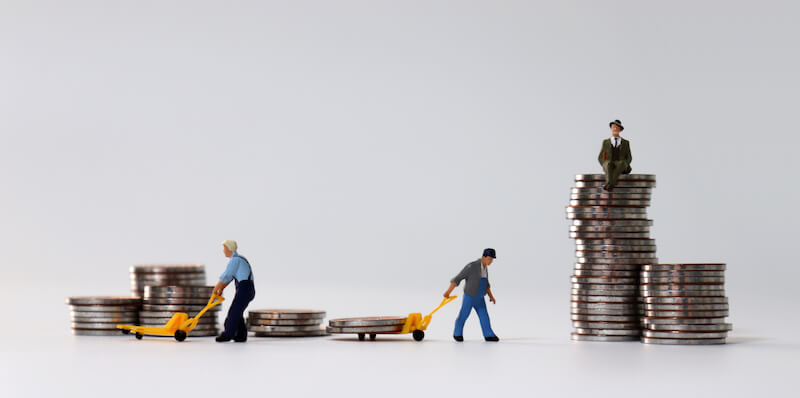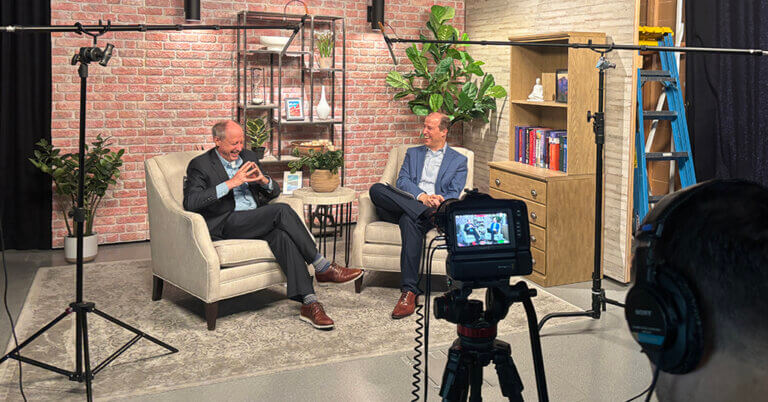June 3, 2020

Wealth and Income Inequality as a Cause of Societal Inequity
Wealth and income inequality have been defining issues in the United States. The added stress of Covid-19 has highlighted and exacerbated these imbalances not only regarding the economy and personal finances, but also for social injustice and civil unrest within communities.
Frighteningly, the most stressed communities have become the epicenters for additional tragic events. Multigenerational income inequality, geospatially identifiable within regions, facilitates further degradation of already fragile neighborhoods.
Statistics Illustrate Wealth Concentration
The wealthiest 10% of the population possess 76% of the nation’s wealth. [1] The calculations of Edward Wolff, a New York University economist, show the following disturbing statistics based on an imaginary total of 100 people in America:
- The top 1 person owns 33% of all the property, stock market, and anything else that can be owned. Most likely male, he owns 33% of everything in this stratosphere.
- The next 4 people own 28% combined, or each owns 7% of everything (not too shabby).
- The next 5 people own 14% combined, or each owns 2.8% of everything.
- The next 10 people own 12% combined, or each owns 1.2% of everything.
So, 20 people account for 87% of the total wealth of this group of 100. Clearly these folks are the upper class. Next comes the shrinking middle class, formerly the backbone of the nation and envy of the world.
- Individuals 21-40 own 9% combined, or each owns 0.87%.
- Individuals 41-60 own 3% combined, or each owns 0.15%.
The above tally [2] accounts for 60 of the one hundred imaginary people and 99% of the wealth. The remaining 40 people are out of luck because they have virtually nothing to own. [2]
Statistically, these bottom 40 people have a negative net worth. They owe more than they own. Some individuals, like a new college grad with student loans or an industrious, dual-earning young couple with a mortgage, are temporarily in this group. However, most of the 40 folks struggle day-by-day and either came from or are about to begin multigenerational hardship.
Translating these one hundred imaginary people to the 326 million in the country should make all of us reflect on the current economic status of America and its consequences.
Wealth vs. Income
We cannot overstate the important distinction between income and wealth. Income is money coming into a family, while wealth is a family’s assets — items like savings, real estate, and businesses minus debt.
The United States Census Bureau defines income as money received on a regular basis by working — wages, social security/other retirement payments, and welfare — minus payments for personal income taxes, social security, union dues, Medicare deductions, etc. Businesses employ the term “cash flow,” defined as the amount of money received for goods and services minus the cost of supplying these commodities.
Wealth is what people own. The sum of all one’s assets minus liabilities equals wealth or net worth. The poorest people or families may get by as long as they have incoming money from a job. However, poor folks have no wealth or reserve and little or no savings; thus, any income interruption — possibly due to something out of their control such as a pandemic, recession, or a natural disaster — is catastrophic.
The wealthiest families may have low earned income because they are not working, but have high unearned income from dividends, capital gains, and other assets. Investment income is the engine that keeps rich families wealthy. Recessions or stock market downturns stress the wealthy but do not devastate wealthy people because markets typically recover. Wealthy families may transiently lower their standard of living somewhat, but never experience the hardship level of a poor family struggling to put food on the table.
Financially successful retirees offer another example of the differentiation between wealth and income. These folks planned and saved and have high wealth but may have little income. Unfortunately, only a minority of the population is in this enviable position; one in four retirees has no retirement savings according to a Federal Reserve 2019 survey. [3]
Sociology of Wealth
Wealth and income combined comprise a family’s total opportunity, typically multigenerational, to secure a desired standard of living. In addition to providing both short- and long-term financial security, wealth often bestows self-perpetuating social prestige and political power. Depending on the inheritance tax laws, family wealth or poverty usually passes on to children. The ability to change social classes has been a fundamental characteristic of America, which previously had a large and dominant middle class. Now with income and wealth inequality, many believe an unhealthy bi-modal distribution of affluence exists.
Wealth removes restrictions, provides comfort, and offers options. Risk-taking is also enabled — in a way not possible for those without abundant assets. The wealthy class lives off investments. In contrast, the standard of living for the middle class is dependent on wages. The growing disparity between the very wealthy and the lower/middle classes is no longer sustainable according to a 2014 Harvard Business School survey of 1,947 alumni. [4]
Causes of Wealth Inequity
The rich get richer and the poor get poorer is a sadly true aphorism. Wealthy people invest and reap fortunes from stocks, dividends, interest, trusts and other forms of unearned income. And unfortunately, people who just get by financially cannot get past the day-to-day needs of existence to save money to invest. For example, sixty-two percent of single-parent families have no savings or other financial assets according to David Grusky’s Social Stratification: Class, Race, and Gender in Sociological Perspective. [5]
Net indebtedness precludes investing, thereby perpetuating dependence on current salary. Any disruption from work or unforeseen expense — car breakdown, new tires, medical illness, pandemic, hurricanes, etc. — pushes those already financially precarious over the fiscal edge.
The disparity between the rich with unearned income and the poor with no reserves compounds multigenerationally. Rich kids can access better education and network easily with other wealthy people. Fellow students and connections probably have better investment opportunities, perpetuating the high rate of unearned income.
Fortunately, public education in America was a great equalizer throughout much of the 20th century. Delivering excellent public education to all children is a core requirement for income, wealth and health opportunities, as Raghuram Rajan notes in The Third Pillar. [6]
Estate and inheritance taxes remain controversial. By decreasing the wealth transfer among generations, death taxes can aid in accelerating class mobility upward or downward. People object to more taxes, especially people of wealth who want to keep their wealth.
Children of wealthy families do have numerous advantages, if they can avoid the disease called “affluenza.” This disease of attitude saps their motivation to work hard, requires instant gratification and consequently encourages living a purposeless life of leisure.
In the U.S., some forms of generational wealth harm following generations. Family farmers owning large tracts of land, an illiquid asset, suffer strain when transferring property to their children. In some other nations with different cultures, the first-born son of a wealthy family was disproportionally advantaged. Ultimately, this male primogeniture culture did not reward merit, thus decreased productivity, and resulted in economic stagnation.
Successful family-owned businesses present another notable exception to generational wealth. Reported data shows that a significant percentage of businesses pass to the second generation. However, only 13% of family-owned businesses last three generations and only 3% survive four generations. “Shirt sleeves to shirt sleeves” is another aphorism that rings true. That’s ironic when the concepts of bootstrapping and building businesses from nothing feature strongly in the American psyche.
Conclusions
Disparities among and within communities with respect to rates of COVID-19 incidence, prevalence, morbidity, and mortality are astounding. These differences link closely to the negative preexisting social determinants of health. Societal stress exacerbates housing instability, food insecurity, social isolation, prejudice and discrimination. The poor folks already suffering at the bottom of the resource pyramid lack the ability to respond to worsening conditions. Others, more fortunate, will use their rainy-day funds to weather the storm.
When the economy stagnates or devolves into a recession or depression, the top 1% does suffer loss of wealth, and the dollar amounts of that loss are often shocking. More critical to the strength of the country is the loss suffered by the millions of people in the middle class. And that greatly affects their daily lives. Former Federal Reserve Chair Janet Yellen stated in a congressional hearing, “There is no question that we’ve had a trend toward growing inequity. This trend can shape and determine the ability of different groups to participate equally in a democracy and have grave effects on social stability over time.”
Loss of the middle class has consequences for all. Wealth disparity creates fertile ground for insecurity, class clashes, political instability and ultimately lawlessness, with subsequent loss of freedom from fear. Extremely high levels of wealth inequity are “incompatible with the meritocratic values and principles of social justice fundamental to modern democratic societies,” according to economist Thomas Piketty in Capital in the Twenty-First Century. He continues, “The risk of a drift towards oligarchy is real and gives little reason for optimism about where the United States is headed.” [7]
Around the world, countries with maldistribution of wealth and power are not as productive or content as America has been over the past century when wealth gaps were smaller. Whereas politicians focus on the next election cycle, statesman should lead the way for successful future generations by growing the middle class, encouraging meritocracy, decreasing income and wealth inequity, and preparing for the next inevitable worldwide crisis.
If leaders enable self-motivated, altruistic people to participate fully in the economy and government, the middle class can grow and re-create a sustaining environment of financial and societal well-being. In turn, the ranks of the disadvantaged will shrink as they migrate to the middle class.
Opportunities abound to educate everyone, encourage industriousness, and leave a legacy for the next generation while preparing and hopefully preventing the next global threat.
Sources
- “Trends in Family Wealth, 1989 to 2013,” Congressional Budget Office, August 2016.
- “Household Wealth Trends in the United States, 1962 To 2016: Has Middle Class Wealth Recovered?” by Edward Wolff, National Bureau of Economic Research, November 2017.
- “Report on the Economic Well-Being of U.S. Households in 2018,” Board of Governors of the Federal Reserve System, May 2019.
- “An Economy Doing Half Its Job,” by Michael E. Porter Jan W. Rivkin, Harvard Business Review, September 2014.
- “Social Stratification: Class, Race, and Gender in Sociological Perspective,” by David Grusky, David B. Grusky.
- “The Third Pillar,” by Raghuram Rajan, 2019.
- “Capital in the Twenty-First Century,” by Thomas Piketty, 2019.
Read David Johnson’s review of The Third Pillar here.





